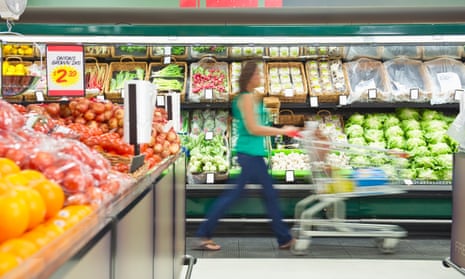It’s easy to switch off during the weekly grocery shop. Everything we need is conveniently at our fingertips, so why bother thinking about where it comes from? If we pick up a banana in the supermarket and see a brown spot, we can exchange it for another. If avocados are $5 this week, there’s always a cheaper alternative in the next aisle. We avoid misshapen carrots and hunt around for the crunchiest, shiniest and cheapest red apples available.
Time to stop the trolleys. The rapidly changing climate is shaking up what makes it to the supermarket shelves and Australian farmers are getting hurt in the process. Droughts, floods, heatwaves, changing rainfall patterns and declining yields are hammering them from all sides, and in a myriad of ways.
Extreme weather events make Australia’s food security increasingly vulnerable and extreme, unpredictable weather is climate change’s specialty. Last summer, for instance, more than 205 records were broken around the country as heatwaves and record hot days scorched many regions – particular in Queensland and New South Wales. As temperatures rise, this alters growing seasons and makes stock management more difficult. It’s not just hotter conditions farmers are worried about, either. Severe flooding is also expected to increase in frequency and, while up in the north there may be fewer cyclones, climate scientists say they will be more ferocious.
Food bowl areas all across Australia, including the Murray Darling basin, are at risk from declining rainfall and heat stress. If farmers cop it, then so do consumers. If we lose agricultural production from these areas, then we will all be giving up an ability to put fresh Australian fruit and vegetables on the table, with ease, every day.
Australia as a whole will suffer because agriculture is a vital cog in our economy and is the most exposed of our industries to climate change. According to the National Farmers’ Federation, the agricultural sector at farm-gate contributes 2.4% to our total gross domestic product (GDP) – or $58.5bn. The majority of the 150,000 farm businesses in Australia are small, family owned businesses, with 96% having a turnover of $2m or less.
So when extreme weather events, including the slow-moving ones like drought, do arrive they hurt farmers hard and fast. Next in line? Shoppers. Consider the sky-high price of bananas following Cyclone Yasi in Queensland as a recent example. Continual, major losses from within this sector are not something that consumers, the economy or government can take lightly.
For those that enjoy a glass of Australian wine with dinner, consider this: according to a recent report by the Climate Council, 70% of Australia’s best grape growing regions are predicted to be in jeopardy by 2050 because grapes will ripen too early. The Shiraz of tomorrow will suffer from our lack of action today.
By failing to swiftly and meaningfully act on climate change, we are dumping a lifetime of extreme weather events and food insecurity onto future generations. The good news is that all shoppers can play a significant role in mitigating the worst impacts of climate change on the food and drink everyone enjoys.
First, demand immediate and meaningful action on climate change from the federal government. The electricity system is by far the biggest polluter. Australia urgently needs smart policies to fix the energy sector and significantly cut carbon pollution. A rapid transition to renewable energy is a must.
Second, now is the time to rediscover paddock-to-plate connections and recognise that food doesn’t start its life on the supermarket shelves. Learning more about the origins of your favourite groceries and buying local can not only reduce food miles and emissions but also support farm businesses all over Australia.
When a dollar is spent on locally produced food, that dollar keeps circulating in the community; paying for Landcare membership, shopping at the local stock feeds or supporting essential services, like kindergartens. By contrast, a dollar spent on cheap imports flies straight out of the country.
Finally consumers can throw their support behind farmers fighting against climate change and come up with a solution. Farmers are custodians of about half of Australia’s landmass. Right across the country, farmers are exploring ways to use renewable energy, regenerate soils and sequester carbon.
The old slogan said “every family needs a farmer”. With climate change upon us, farmers need all families to stand up for Australian agriculture. Doing so will give future generations of farmers as well as consumers the quintessential Aussie fair go.
